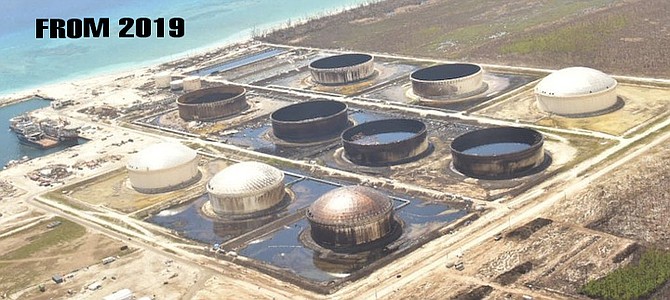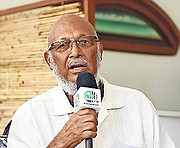By DENISE MAYCOCK
Tribune Freeport Reporter
dmaycock@tribunemedia.net
ACTIVIST Joseph Darville has called for more vigilance concerning the rehabilitation of the area affected by the Equinor oil spill in East Grand Bahama.
After visiting the area on Thursday, Mr Darville expressed his concern about the treated soil in that area by Equinor.
Mr Darville, a representative of the environmental group Save the Bays, was checking the progress of the clean-up.
He told The Tribune: “The area covered with that (treated) soil. I am wondering what they are going to do there now? Are they going to replant something in that area, possibly pine trees?”
Mr Darville said the area in question is probably about 150 acres, from the roadside in the front of the plant and extends north into the forest.
“They (Equinor) took up all the ground soil, including the residual oil they were not able to suck up, and transported it onto their property. They were rehabilitating it; they were trying to get rid of the oil content. They brought it back and spread it out over that area, and people who frequent the area have reported to me that it smells of petroleum,” he said.
Mr Darville has taken a sample of the treated soil for testing.
“The soil is also a dark brown colour, but I am not overly concerned with that. The Environmental Department will have to check - if they have not done so already - to see whether there was sufficient treatment and whether or not it is okay for it to be there with the rains that will come in the spring and about residual going into the water table.
“I think that it needs to be monitored very carefully by the Environmental Department and I call on them to be vigilant with the ongoing rehabilitation of that whole area.”
Mr Darville thinks that monitoring was neglected by the previous administration.
“If it were not for Save the Bays and Waterkeepers Bahamas, we probably would not have known what was going on out there,” he said.
During his observation, Mr Darville noted that clean-up had taken place at the aggregate business impacted by the spill.
“I was pleased in one sense to see that the oil on the massive machinery and equipment was all gone and cleaned up, as well as the 50ft to 60ft high mound of aggregate covered in crude oil and the surrounding areas - that was also of concern to us.”
However, Mr Darville also noticed no cleaning had taken place on the north side of the aggregate mound.
He believes the reason was due to the massive amount of vegetation that has grown back in the area.
“It would be detrimental to destroy that much greenery,” Mr Darville said.
He added it appears cleaning has stopped, even though a large area in the forest still has oil residue on the ground.
The environmental activist reported that about 25 to 30 percent of the Palmetto Palms (also known as thatch palms) have died because of the oil spill. He said that thatch can withstand saltwater, fires, and hurricanes, but not oil.
“Many of them got oil down the hearts, and when oil enters the heart, they die. And a large number of them died due to the oil,” Mr Darville said.
The wetland is another area that is still significantly affected, according to the activist.
“They cannot do anything with that because they would do more damage to the wetland trying to recoup the oil that has already sunk into the mud where the mangroves and swamp grasses have grown,” he said.
Mr Darville said the Bahamas National Trust has also conducted assessments in the area and expects to meet with management at Equinor to discuss their findings.
He hopes STB and WKB are invited to that meeting as well.
The issue of compensation is another area that has to be addressed, Mr Darville said.
“We (STB and WKB) have been keeping a very vigilant eye on that area. And my concern now is why the government, whether it is the previous government or present government, has not indicated to the public what compensation we would receive for the catastrophic damage to the pine forest from the oil spill of some 55,000 barrels.”
Still, Mr Darville commended the staff at Equinor for their cooperation.
“I salute the staff at Equinor. I do not want to demean them because they were very appreciative of us, keeping their feet to the fire. They invited us frequently for an update on what was happening.
“We agreed with the process they were going on with, except I decried… the lack of our (Bahamian) personnel that could have been there originally to make sure that the thousands of acres were cleaned up more rapidly. I do not think they had sufficient manpower to do that,” he said.
The oil spill occurred at Equinor’s South Riding Point storage facility in Grand Bahama when Hurricane Dorian pummeled the northern Bahamas in September 2019.
The estimated volume of the oil spill is 55,000 barrels (2.3 million gallons).
After the incident, Equinor said it was committed to cleaning up the area and that it would establish a long-term monitoring plan of ground water and for the affected forest areas to be submitted to local authorities.






Comments
One 2 years, 3 months ago
Bahamas government and regulation is too weak to support this type of operation. The next hurricane will do the same thing. Image how much was already washed away by the storm.
Sign in to comment
Or login with:
OpenID